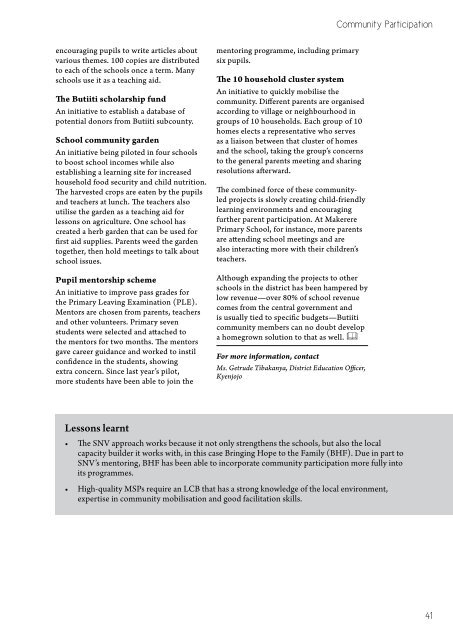School Priorities - SNV
School Priorities - SNV
School Priorities - SNV
You also want an ePaper? Increase the reach of your titles
YUMPU automatically turns print PDFs into web optimized ePapers that Google loves.
Community Participation<br />
encouraging pupils to write articles about<br />
various themes. 100 copies are distributed<br />
to each of the schools once a term. Many<br />
schools use it as a teaching aid.<br />
The Butiiti scholarship fund<br />
An initiative to establish a database of<br />
potential donors from Butiiti subcounty.<br />
<strong>School</strong> community garden<br />
An initiative being piloted in four schools<br />
to boost school incomes while also<br />
establishing a learning site for increased<br />
household food security and child nutrition.<br />
The harvested crops are eaten by the pupils<br />
and teachers at lunch. The teachers also<br />
utilise the garden as a teaching aid for<br />
lessons on agriculture. One school has<br />
created a herb garden that can be used for<br />
first aid supplies. Parents weed the garden<br />
together, then hold meetings to talk about<br />
school issues.<br />
Pupil mentorship scheme<br />
An initiative to improve pass grades for<br />
the Primary Leaving Examination (PLE).<br />
Mentors are chosen from parents, teachers<br />
and other volunteers. Primary seven<br />
students were selected and attached to<br />
the mentors for two months. The mentors<br />
gave career guidance and worked to instil<br />
confidence in the students, showing<br />
extra concern. Since last year’s pilot,<br />
more students have been able to join the<br />
mentoring programme, including primary<br />
six pupils.<br />
The 10 household cluster system<br />
An initiative to quickly mobilise the<br />
community. Different parents are organised<br />
according to village or neighbourhood in<br />
groups of 10 households. Each group of 10<br />
homes elects a representative who serves<br />
as a liaison between that cluster of homes<br />
and the school, taking the group’s concerns<br />
to the general parents meeting and sharing<br />
resolutions afterward.<br />
The combined force of these communityled<br />
projects is slowly creating child-friendly<br />
learning environments and encouraging<br />
further parent participation. At Makerere<br />
Primary <strong>School</strong>, for instance, more parents<br />
are attending school meetings and are<br />
also interacting more with their children’s<br />
teachers.<br />
Although expanding the projects to other<br />
schools in the district has been hampered by<br />
low revenue—over 80% of school revenue<br />
comes from the central government and<br />
is usually tied to specific budgets—Butiiti<br />
community members can no doubt develop<br />
a homegrown solution to that as well. <br />
For more information, contact<br />
Ms. Getrude Tibakanya, District Education Officer,<br />
Kyenjojo<br />
Lessons learnt<br />
• The <strong>SNV</strong> approach works because it not only strengthens the schools, but also the local<br />
capacity builder it works with, in this case Bringing Hope to the Family (BHF). Due in part to<br />
<strong>SNV</strong>’s mentoring, BHF has been able to incorporate community participation more fully into<br />
its programmes.<br />
• High-quality MSPs require an LCB that has a strong knowledge of the local environment,<br />
expertise in community mobilisation and good facilitation skills.<br />
41
















